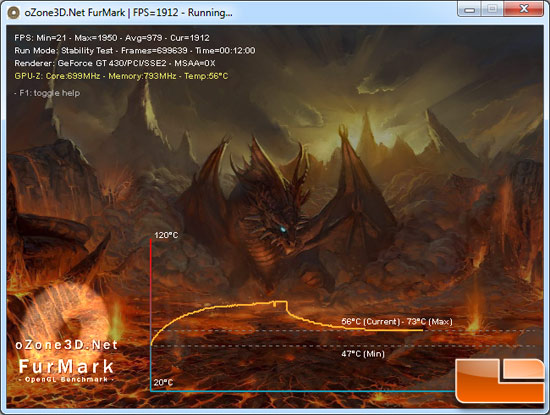ASUS GeForce ENGTX560 Ti DirectCU II Video Card Review
Temperature Testing
Temperature Testing
Since video card temperatures and the heat generated by
next-generation cards have become an area of concern among enthusiasts
and gamers, we want to take a closer look at how the ASUS GeForce GT 430
`GB graphics card does at idle and under a full load.
ASUS ENGTX560 Ti DirectCU II Top Video Card Idle Temperature:

As you can see from the screen shot above, the idle state of the ASUS GeForce GTX560 Ti drops the GPU core clock frequency down to 50.6MHz
and the memory clock down to 67.5MHz to help conserve power and lower
temperatures. At idle on an open test bench the ASUS ENGTX560 Ti video
card temperature all along was observed at 28C. The fan speed on the
card was at 13% and fairly quiet with the fan spinning at just 1170RPM.
ASUS ENGTX560 Ti DirectCU II Top Video Card Load Temperature:

We fired up FurMark and ran the stability at 640×480, which was
enough to put the GF108 GPU core at 100% load in order to get the
highest
load
temperature possible. This application also charts the temperature
results so you can see how the temperature rises and levels off, which
is very nice. The fan on the NVIDIA GeForce GT 430 1GB video card was
left on auto during temperature testing and the fan speed never changed,
which was interesting. When we hit the space bar to stop the rendering
the
temperature dropped. The peak temperature reported on the open air test
bench was 73C.

The GPU fan was only at 60% when at this temperature, so cooling can
easily be improved if you manually want to set the fan to a higher RPM.
Not bad results from a Fermi core with such a small heat sink and
cooling fan, in all honesty.

AS you can see the ASUS ENGTX560 Ti DirectCU II Top video card has roughly the same idle temperature as the NVIDIA GTX560 Ti reference design, but is much cooler at load. Our testing shows that this cooler keeps this GTX560 Ti at roughly the same temperature as the companies GTS450 with their previous version DirectCU cooler!

Comments are closed.